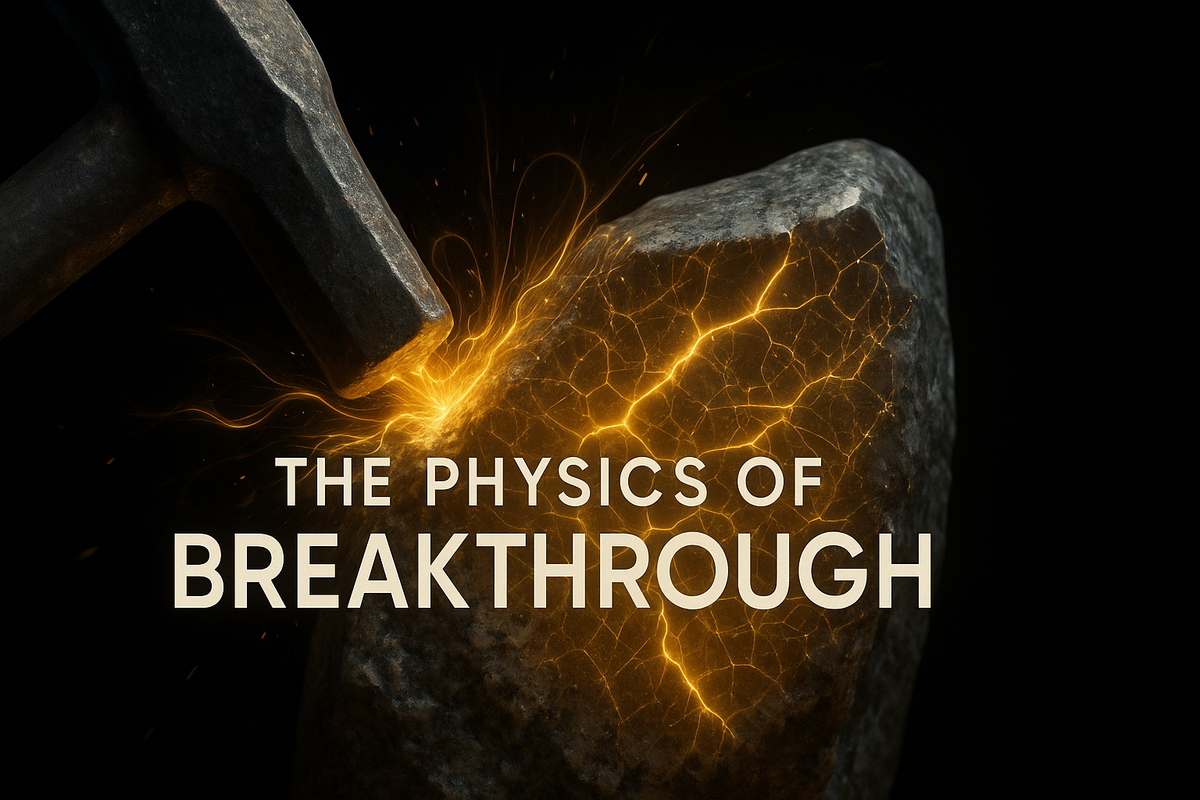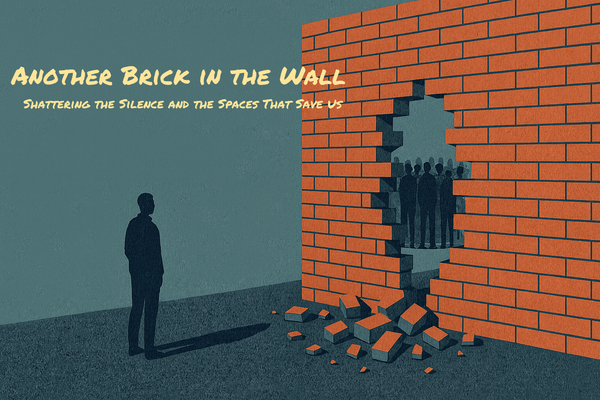The Physics of Breakthrough: Why Small Actions Create Exponential Results
Each hammer blow transmits energy into the stone's molecular structure, accumulating in an invisible reservoir. The breakthrough isn't caused by the final blow; it's the inevitable release of all that stored energy reaching critical mass.

"When nothing seems to help, I go and look at a stonecutter hammering away at his rock perhaps a hundred times without as much as a crack showing in it. Yet at the hundred and one blow it will split in two, and I know it was not that blow that did it, but all that had gone before."
This ancient wisdom contains a profound truth about how the physical world actually works. What appears to be sudden breakthrough is actually the visible manifestation of invisible accumulation. The stonecutter's metaphor isn't just motivational; it's physics in action.
The Energy Transmission Principle
Here's what's happening at the molecular level that most people never consider: when hammer meets stone, kinetic energy doesn't vanish. It transforms. The impact converts your swing's motion into stored energy within the stone's structure. Think of it as charging a battery, one blow at a time.
Each impact creates what physicists call elastic deformation. The stone actually absorbs and holds the energy you put into it. Microscopic regions compress, twist, and strain. The material stores this energy in its internal structure, like a spring loaded with potential force.
This stored energy doesn't decay or disappear between hammer blows. It accumulates. Blow by blow, the stone builds up an internal energy reservoir that's completely invisible from the outside. You can't see it, measure it, or feel it, but physics guarantees it's there, growing with each impact.
The breakthrough moment occurs when the total stored energy finally exceeds the stone's capacity to contain it. All that accumulated energy, from blow one through blow one hundred, releases simultaneously in the fracture. The final blow doesn't break the stone. The accumulated energy breaks the stone. The final blow just pushes the system past its storage limit.
Every hammer blow on stone doesn't just hit and disappear. It transmits energy directly into the stone's molecular structure. That kinetic energy from your swing gets converted into stored potential energy within the material itself. Crystal lattices deform slightly. Internal stress fields build up. Molecular bonds stretch and strain, holding that energy like a compressed spring.
The stone becomes an energy storage device, banking every joule of force you apply. Each blow deposits more energy into this invisible reservoir until the total stored energy exceeds the stone's structural capacity to contain it. Then all that accumulated energy releases at once in the fracture.
This is fundamentally different from how we typically think about effort and results. We expect linear relationships: work harder, get proportionally better results. But the physics of breakthrough follows exponential patterns where small, consistent inputs create sudden, dramatic outputs.
Think about heating water. From 32°F to 211°F, you add tremendous energy and see steady, measurable temperature increases. But at 212°F, something extraordinary happens. The same amount of additional energy that raised the temperature one degree now transforms the entire substance. Water becomes steam, expanding to 1,700 times its original volume. One degree creates exponential change.
The Compound Mechanics of Persistence
The stonecutter's hammer follows the same physics as compound interest, but with a twist. Financial compound interest grows gradually and visibly. Physical compound effects often accumulate invisibly until they reach a phase transition: a point where the system reorganizes itself entirely.
Consider how muscles develop strength. Individual workouts create microscopic tears in muscle fibers. These tears are so small they're undetectable day to day. Your strength might seem unchanged for weeks. But beneath the surface, the muscle is rebuilding itself stronger. When you finally notice the difference, it feels sudden. It wasn't. It was exponential accumulation reaching a visibility threshold.
This explains why most people quit before breakthrough. They're measuring progress on the wrong timeline. They expect to see each hammer blow's individual impact rather than understanding they're making deposits in an energy bank that will pay dividends all at once.
Critical Mass and Tipping Points
In nuclear physics, critical mass is the minimum amount of fissile material needed to sustain a chain reaction. Below this threshold, neutrons escape the system, and the reaction dies out. Above it, each fission triggers others in an exponential cascade that can power cities or level mountains.
Your daily efforts follow similar principles. Each small action, each day you practice, each time you show up, and each moment you choose growth over comfort adds to your critical mass. Most people never reach their tipping point because they stop adding material to the reaction before it becomes self-sustaining.
The stonecutter understands this intuitively. He knows that blow 99 and blow 101 contain essentially the same force. But only one of them appears to "work." The difference isn't in the individual effort. It's in the accumulated energy that finally exceeds the stone's resistance threshold.
The Fracture Mechanics of Success
Engineers study how materials fail under stress, and their findings reveal why the breakthrough blow appears so powerful. Stress concentrates along microscopic flaws and imperfections. Each impact slightly enlarges these weak points. Eventually, the accumulated damage reaches a critical level where the entire structure can no longer maintain its integrity.
This is why your "overnight success" after years of invisible progress isn't luck or timing. It's accumulated stress on the obstacles in your path finally exceeding their structural limits. The system reorganizes around your persistence.
Consider learning a complex skill like playing piano. For months, your fingers fumble over keys. Progress feels impossibly slow. Then suddenly, muscle memory clicks. Your hands seem to know where to go without conscious thought. This isn't magic; it's neural pathways reaching sufficient strength and connectivity to operate automatically. Invisible accumulation becomes visible capability.
The Exponential Deception
Our brains are wired to expect linear results because that's how most of our daily experience works. Walk twice as far, and you get twice as tired. Eat twice as much, and you feel twice as full. This linear thinking makes exponential accumulation feel broken or ineffective.
But exponential systems operate differently. They appear to do nothing for a long time, then everything happens at once. The first penny doubled daily becomes two cents. Still disappointing. After a week, you have less than a dollar. After two weeks, barely $80. But by day 30, you have over $5 million. Day 31 brings you to more than $10 million.
The stonecutter's hammer follows this same exponential curve. Each blow feels equally ineffective until the accumulated energy reaches the breaking point. Then physics takes over, and all that stored energy releases in a fraction of a second.
Why Small Things Matter More Than Big Things
Counterintuitively, the size of each individual effort matters less than its consistency and accumulation. A massive blow to the stone might create more immediate visible damage, but it doesn't necessarily move you closer to breakthrough faster than consistent smaller impacts.
This is because breakthrough isn't just about total energy applied. It's about how that energy accumulates in the system's weak points. Consistent pressure allows stress to concentrate and compound. Irregular pressure, even if more forceful, often dissipates before it can accumulate to critical levels.
This explains why steady, unsexy consistency often defeats sporadic heroic efforts. The physics favors accumulation over intensity.
The Invisible Inventory
While you're swinging the hammer, the universe is keeping an invisible inventory of your efforts. Every early morning when you didn't feel like starting. Every practice session that felt pointless. Every day you chose discipline over comfort. These don't disappear into nothing. They convert into what physicists call potential energy: stored force waiting for the right moment to express itself.
The stone doesn't care about your feelings or timeline. It's simply responding to the total accumulated stress you've applied to its structure. When that stress exceeds its resistance threshold, it will split. The breakthrough isn't a reward for persistence. It's a physical inevitability.
Beyond the Breaking Point
But here's where the metaphor becomes even more powerful. The stonecutter's goal isn't just to break one stone. It's to develop the skill, strength, and understanding that makes future stones easier to split. Each breakthrough builds momentum for the next one.
When you finally break through in one area, you don't just solve that specific problem. You prove to yourself that the physics work. You develop confidence in the accumulation process. You learn to trust that invisible progress is still progress.
More importantly, you develop what we might call "breakthrough momentum." Each success makes you more willing to swing the hammer on the next stone, knowing that apparent lack of progress doesn't mean lack of accumulation.
The Compound Return on Pounding Stone
The most successful people understand that breakthrough isn't the end goal. It's the beginning of exponential returns. When you break one stone, you don't just get the result you were working toward. You get proof that the physics work for you personally; increased skill and efficiency for the next challenge; momentum that makes starting easier; confidence to tackle bigger stones; and understanding of how to read the invisible signs of progress.
This creates a compound effect where each breakthrough makes future breakthroughs more likely and faster to achieve. You're not just splitting stones. You're building a breakthrough generating system.
The Mathematics of Miracles
What we call miracles often follow predictable mathematical patterns. The "sudden" success follows a power law distribution where small, consistent inputs create dramatically disproportionate outputs. The apparent randomness of timing isn't random at all. It's the moment when accumulated effort crosses the critical threshold.
Scientists have observed this pattern everywhere: in viral growth, avalanche formation, ecosystem collapse, and forest fires. Small actions accumulate below the surface until they reach a tipping point, then transform entire systems almost instantaneously.
Your personal breakthroughs follow identical physics. The day you finally break through isn't special because of what you did that day. It's special because it's the day your accumulated efforts finally exceeded the resistance of whatever was holding you back.
Practical Physics: How to Pound Your Stone
Understanding the physics changes how you approach persistent effort. Focus on consistency over intensity. The stone responds to accumulated stress, not peak force. Better to swing the hammer every day for a year than to swing it perfectly once a month.
Trust the energy transmission. Every effort you make transfers energy into the system, even when you can't see results. The absence of visible progress doesn't indicate the absence of energy storage. Physics guarantees that consistent energy input creates accumulated potential for breakthrough.
Recognize proximity to breakthrough. As you approach critical mass, small improvements in technique, frequency, or force can dramatically accelerate the timeline. This is why many people break through just after they were ready to quit. They were closer than they realized.
Understand that breakthrough changes everything. When the stone finally splits, you don't just win that battle. You prove that the physics work for you, which changes your approach to every future challenge.
The Exponential Revelation
The stonecutter's wisdom reveals something profound about how reality actually operates. What appears to be sudden transformation is usually the visible expression of invisible accumulation. What seems like overnight success is typically the result of energy building below the surface until it reaches critical mass.
This isn't just true for breaking stones. It's true for building skills, developing relationships, creating businesses, changing habits, and transforming any aspect of your life. The physics are universal: consistent small actions compound into breakthrough moments that appear sudden but are actually inevitable.
The next time you're tempted to quit because you don't see immediate results, remember the physics. Your efforts aren't disappearing into nothing. They're accumulating in an invisible energy bank that will pay exponential dividends the moment you reach critical mass.
The stone is storing every joule of energy you transmit into it, even when you can't see the accumulation. Your job isn't to count visible cracks or measure immediate results. Your job is to keep transferring energy into the system and trust physics to reach the critical threshold.
The breakthrough isn't coming in spite of all those "ineffective" blows. It's coming because each blow transmitted more energy into storage. When that accumulated energy finally exceeds the stone's capacity to contain it, the release is inevitable. That's not motivation. That's the fundamental physics of energy transmission and storage reaching critical mass.
This article was inspired by the wisdom shared in "Pound the Stone" by Joshua Medcalf. The stonecutter metaphor and its profound insights into the nature of persistent effort serve as the foundation for exploring the physics principles behind breakthrough moments. Learn more about Joshua's work at train2bclutch.com.




